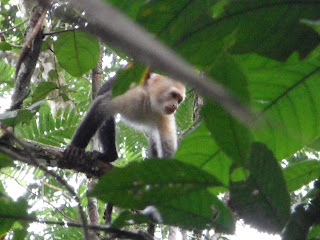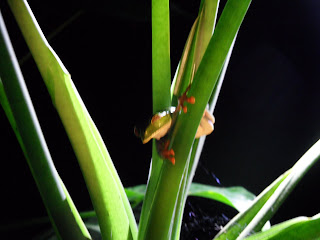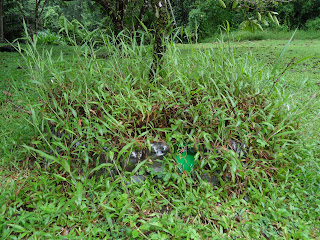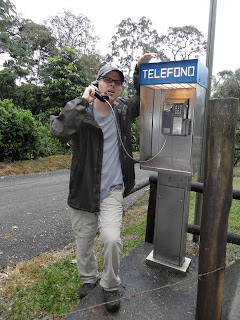
Sunday, December 4, 2011
Home!
Finally home after a long day of travel yesterday from San Jose, Costa Rica, to Dallas, Texas and finally to San Diego! Got in about 7:30 P.M. and was met by my family!
What a wonderful trip, but how much more wonderful to be home again and ready to share all my experiences.
Sorry for the lack of posts the last few days - we did not have internet access!! Let's just say you can look forward to some new pictures in the upcoming week of:
Zip-lining 300 feet above the canopy
The Arenal volcano (covered with clouds - sorry)
And MORE!
Thanks for following along on my adventure!
Wednesday, November 30, 2011
Day 11
La Selva
Today the group travelled about 30 minutes from the hotel to La Selva Biological Research Station, which is a protected reserve of about 4000 acres. Here, scientists from all over the world come to study the plants, animals and ecosystems present in the rainforest.
We were very lucky today, as we got to actually participate in maintaining the rainforest, and helping to preserve its natural state. We had some hands-on experience with eliminating non-native, invasive species in the rainforest to make way for the natural flora to repopulate the area. Specifically, we were pulling out coffee plants that were introduced as a crop many years ago, but have since taken over the ground, light and water spaces of other native plants. Back-breaking, dirty work, but it felt great to give back and help this incredible ecosystem, even if only for one morning.
For my students: What other way do you think we can help the rainforest and these fragile ecosystems, plants and animals in our own lives? We live thousands of miles away, but the fact is that our everyday lives affect the lives of this very rainforest I am standing in today. What do you think?
In the afternoon, we got to go on a walking tour of the La Selva reserve with two naturalists pointing out and giving us information on all the wonders we were able to see. Leaf-cutter ants, toucans, howler monkeys, poison dart frogs, and peccaries, just to name a few!! An amazing time in an incredible place that I will never forget…
Pictures below…
This is called the Owl Butterfly. What patterns of other predators do you see on its wings?

This is, apparently, where the sidewalk ends...

No clue on the species, but what a great looking bird!

This is a howler monkey!!

Iguanas live in trees and eat leaves.

This is a peccary - it's a member of the pig family.

A view from one of the many bridges over the Sarapiqui River.

A Toucan! Finally!

Leaf-cutter ants at work. Amazing stuff.
Tuesday, November 29, 2011
Day 10
Today we were picked up from our host family, and brought back to EARTH Universtity where we picked up the rest of our luggage. 1 ½ hours later, we arrived at the Selva Verde lodge, in Sarapiqui, Costa Rica. It was a bit sad to leave Elias and his family, as they had been so wonderful to us, but I was excited to begin the next part of my adventure.
Finally, we spent some time in the jungle that I had been imagining for so long on this trip. Today I saw monkeys, snakes, frogs, lizards, caimen , hundreds of insects, exotic birds and bats all in about 12 hours! The biodiversity of this place is staggering, and I am just amazed at the amout of species even in this reserve, which accounts for only about 900 hectacres.
The lodge itself is right in the middle of the preserve, and we can walk just a few feet and feel like we are in the middle of the jungle! Last night we went on a night hike with our guides, and were able to encounter all sorts of different animals, a LOT of which I was then able to cross of my lists that the students had prepared for me! Red-eyed leaf frog? CHECK! Pictures are below!
The next morning we were off to the Trimbina Ecological Preserve where we were treated to everything from walking across an 800 ft suspension bridge over a raging river, to seeing how chocolate is made an harvested from the Cocoa tree! Amazing stuff! Pictures are below to help me try to describe the wonders we saw here today.
Finally, we got up close and personal with one of the most important species of mammal is the entire world: bats. We got to see them up close (with the help of the local conservationists who captured a few), and learned how essential bats are to an ecosystems. Of all the mammals in the WORLD, bats make up…what percent? Can you guess? I will tell you tomorrow!!!

This is an anole lizard.

Tree iguana! He was massive!

This suspension bridge we crossed is over 800 ft. - one of the longest in Costa Rica!

Another white-faced monkey.

Look at how this vine twists!

The Costa Rican Caimen!!!!

Poison Dart frog - my students: find out which one it is!

Ahh. Check another one off the list! Not a great picture, but this is the red-eyed leaf (or tree) frog!

Guess what this plant is? The beans inside that fruit are used to make something we all love VERY much...

Day 9 - Homestay!
Day 9
Well, after a long drought of no internet access – I’m back!!
The last few days have been amazing! One of the highlights of this trip so far was the opportunity to spend 24 or so hours with a Costa Rican Family on a sustainable farm. Three of us stayed on a wonderful farm called Finca Chiquita.
On the farm, Elias, his wife and his daughter grew their own crops, had a pond full of tilapia, alongside chickens, rabbits, cows, pigs and assorted other animals. Essentially, what they needed on a daily basis was available on the farm. If it was something they did not have readily available (which was often – one farm can only support so many crops and animals), they were able to either buy at the local market, or trade for with one of the other farms in their local area. Amazing stuff!
There were three of us who stayed with the family that night and the next day, and we were fed well and treated like honored guests! Although their way of life is simple, it was rich in community and family ties, as well as having a direct connection to the land that was worked. We were able to assist Elias in his work on the farm, from feeding the animals to cutting down trees for fence posts with a machete! It was hard work, but worth every second. In the end we were able to see and appreciate the way of live that is lived in rural Costa Rica, and get some wonderful insight into what it takes to actually provide for a family!
On this farm, they also used a very ingenious system called a bio-digester. Essentially, all waste products from animals (in this case, specifically pigs) are collected and allowed to go through the decomposition process naturally. One result of this decomposition is the release of methane gas. Methane gas is flammable, and can be collected to be used in cooking! Amazing!
The dinner we had the first night was a result of squash and other vegetables we picked in their gardens, different fruits for desert, and even some chicken and beef received from the other local farms. I have never had meal more fresh to the table!
Question for my students: what would YOU have to grow to support the things that you eat every day? Is there even one product that you could produce at your own house that would prevent you having to buy it from a store?
Here are some pictures to sum up the experience:
The home we stayed in!

Here are the bags that collect the methane gas, for use in the house. There is a pipe that leads from this area into the kitchen where it connects to the stove!

Here I am picking the squash that will eventually be part of dinner!

Here is dinner that evening!

As I said, we got to work all morning in the fields. Those big boots are necessary because of the mud (it rains a lot in the rainforest, you know). We were cutting down trees with machetes!

Saturday, November 26, 2011
Day 8 - Off to Homestays
Here's something for my students to think about today:
If you were going to stay with a Costa Rican family for a night, and were asked to bring them a small gift in appreciation, what would you bring to represent your hometown (San Diego) and California?
Until I post again - be safe all!
Friday, November 25, 2011
Food!
Try to figure out what you are looking at, and for my classes, try to trace a possible path for each one of the main staples on the dish from the field to the plate! Just like our journey of the Apple!!




Picture Time!

Millipede - not dangerous, kids. Sorry!

Why did the armadillo cross the road? I dunno, but this was a surprise!

These are NOT wild...pigs at the EARTH University sustainable farm. Get this - they use the methane gas produced from the pig's...droppings...as an energy source!

Banana plantation!!

Banana processing plant.
Below is something called the Banana Train. It's how they get the bananas from the field to the processing plant!
Day 7 - Internet problems!
Lots of problems connecting today, so I am taking advantage of this short window of "working" to post quickly.
Better today, so CHECK BELOW!
Just as a quick side-note, it has been raining non-stop for the last 2 1/2 days. Can my students think about the geography of where WE live and speculate as to what would happen if WE had rain for 2 1/2 days straight? I will talk about why that's not so bad here in Costa Rica later!
One picture for you all:

EARTH University, where we are staying for three days!
Also, as it is working for 5 minutes again, I will be OUT of internet contact for the next two days as we go in groups to stay with a Costa Rican family on a sustainable farm!
Look forward to many updates coming soon, though!
Day 6

Liceo de Pacora is a provincial high school, which had about 500 students ranging from grades 7-11. We visited the school at the end of their year, with just a few weeks left until their big "summer" break! The students were finishing exams, and we got the feeling they were very much looking forward to summer just like our student would.
Summer for Costa Rican students takes place in the months of December and January. The reason they have the big break at this time is because the rain in Costa Rica finally lets up for these two months. It is the dry season!

The students performed for us today, giving us a glimpse into their lives, and the lives of those at this school. Liceo de Pacora is in a very rural part of Costa Rica, and these students seemed to very much appreciate the limited resources they were given while attending school. For some, school is the only safe place they might have. The most inspiring thing was that even though the students lived for the most part below the poverty level here, their attitudes were incredible and we felt honored to be able to participate in their school, even if only for a day!

We spent the afternoon today talking with the experts at EARTH University about recycling and waste management. We saw an eye opening movie about Guatemala City and it’s urban dump called “Recycled Life”. It’s tough to watch, but is truly an amazing look into the lives of people in Guatemala that we might never otherwise see. I recommend renting this if you have time – even my students!
Composting Pile...

We traveled all over the EARTH University campus seeing how they deal with the overwhelming task of staying as close to the sustainability line as possible. We saw great examples of recycling, composting, and proper land use management. Amazing things they are doing here! This university grants students from all over the world (mostly 3rd world countries with aggro economies) a place to study, with full scholarships to over 50% of the students. The rest receive some aid, but almost all return their home countries to better the agricultural business practices there!
I think the picture below is a great example of "Re-use".

While we were touring the grounds, I saw TONS of new animals and plants, a few of which my students will love to see, AND even more that I can share with you in the pictures below:
Another 3-toed Sloth! Look at its head craning around to look at us!

More coming soon!
Thursday, November 24, 2011
Day 6 - Thanksgiving!
Wednesday, November 23, 2011
Day 5
This morning started early again!!
At 5:30 our bags were collected and put on the bus, and we were off to visit our first school. Blue Valley school is located in a suburb of San Jose, and it was our last day here until the end of our adventure on December 3rd. That day seems so far off, but at the same time I cannot believe I have been away for 5 days!

Blue Valley school has about 600 students, ranging from kindergarten to 12th grade. Remember that in Costa Rica primary school is K-6, and high school is 7-11. The extra year in high school is required if a student wants to pursue the International Baccalaureate diploma, like students can do at Granite Hills high school next to us! If my students are thinking that Blue Valley must be an IB school - you would be correct! I saw a lot of project based-learning, just like we have at home.

One thing we saw that really impressed me was the younger students putting on a brief performance for their classmates on why we celebrate Thanksgiving in the States. Although they do not celebrate the holiday in Costa Rica, I thought it was wonderful that they were taking the time to explore traditions and customs of other countries and cultures! I think we are on the right path to do the same at Montgomery.

We were also able to hear some of the older high school students present information on the various clubs and electives they have that focus on environmental awareness. In a country that is so rich in biodiversity, it was encouraging to see the future leaders of the country focused on preserving their rich national heritage and ecology.
We then boarded the bus and were off to EARTH university, where we will spend the next 3 days. On the way, however, we stopped at one of the most amazing archeological ruins I have had a chance to visit!
Oh, by the way - it RAINS in the RAIN FOREST. A LOT!

Raining in the rainforest!

Guyabo National Monument is a pre-Columbian ruin of a very holy site, with many different structure remains and a working underground aqueduct system that is over 2,000 years old!! This was a very holy site for the early indigenous people of Costa Rica, and is now considered a World Heritage Site.

Foundations of the ancient structures

My students especially will appreciate these next few sentences, because as well as being an outstanding historical site, Guyabo is in the middle of the rain forest. WOW! You just have no idea what immense biodiversity there is here until you walk amongst it. The sheer amount of plants and animals we saw on a short 1 1/2 walk was amazing. Guess what, my dear students? I can cross off TWO things from our scavenger hunt lists already!!
We saw a three-toed sloth lounging in the treetops, curled up against the rain, I took a picture, which is below, but my camera would not zoom enough to get a clear picture. Look very closely in the V of the far tree - you will see a bundle of fur crouched in the branches!

This next sighting will excite my students no doubt - a hog-nosed viper! It's in the same family as the golden eyelash viper in our lists, and is extremely deadly! Stayed well clear, and was still able to get a great picture for you all.

More information coming tomorrow for everyone.
Ok students, here is something to think about for today: we visited an ancient site today where only the remains of the civilization are evident. Not much is left, after all these years. Pretend for a moment that a new site was discovered completely intact - with all the artifacts and treasures contained in the tombs or structures. What to you think is the correct way to treat those relics? Do they belong in a museum, protected from decay and theft, or should they be left alone in their original place, to respect the wishes of the original builders?
Lots to think and write about. More coming tomorrow!
Happy Thanksgiving to everyone who is following along!
- Posted using BlogPress from my iPad

